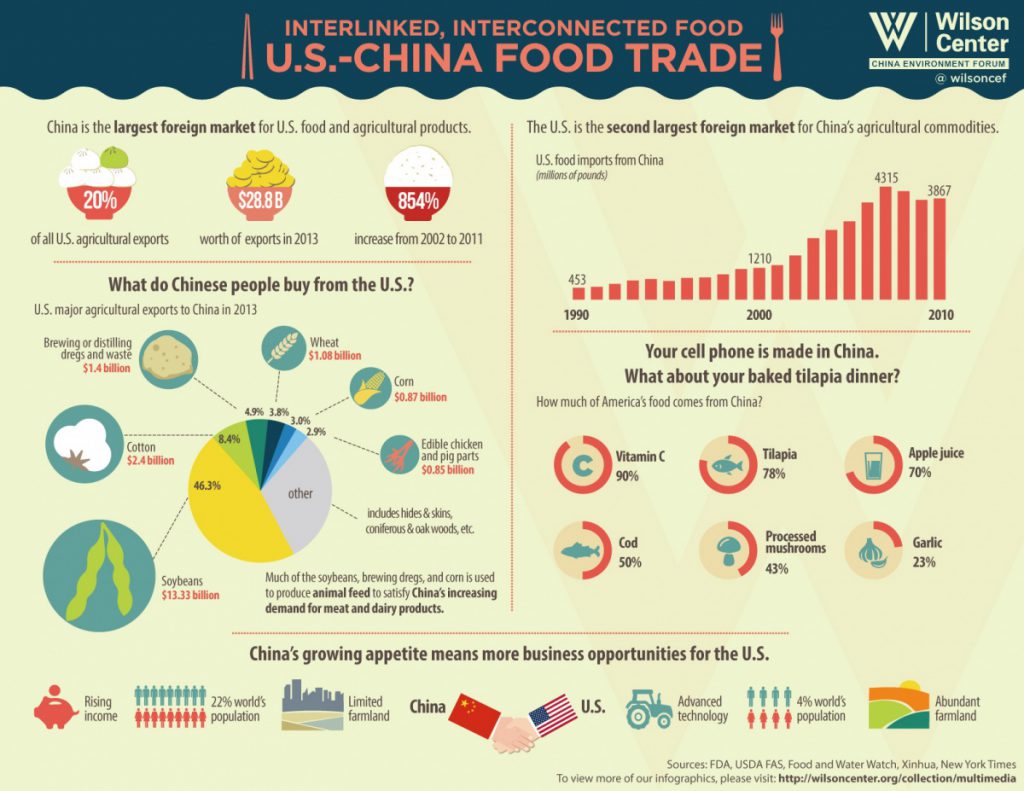
2020 Update: The blog below remains one of our most popular on the website, and there has been increased interest in it during the coronavirus crisis. The United States continues to import food from China, including $4.6 billion worth in 2017 alone. Top imports include fruits and vegetables, snack foods, spices and tea. In 2019, for example, the U.S. imported $89 million worth of tea and $300 million worth of apple juice.
Do you know where your vitamin C comes from? How about that glass of apple juice? Or that tilapia you ordered at dinner the other night?
Chances are, all three came from China.
Along with importing plenty of electronic products, clothing and other manufactured goods, the United States imported roughly 3.9 billion pounds of agricultural products from China in 2010 — making it the second largest market for such goods.
The China Environmental Forum at the Woodrow Wilson Center put together an infographic highlighting the most popular agricultural imports from China. Politico Pro reports:
China is responsible for 90 percent of the vitamin (C) consumed by Americans, 78 percent of the tilapia, 70 percent of the apple juice, 50 percent of the cod, 43 percent of the processed mushrooms and 23 percent of the garlic.
As the infographic notes, the food trade between China and the United States is interconnected. China imported $13.33 billion worth of soybeans, $2.4 billion worth of cotton and $1.08 billion worth of wheat in 2013.
But the United States is going to need to sell a lot more soybeans to hit even, given that we continue to import an incredible amount of stuff from China. After all, the monthly U.S. goods deficit with China reached $30.9 billion in July, an all-time high.
But it’s not just trade figures that are troubling about agricultural imports from China — a number of food safety scandals have rocked China in recent years.
Just this summer, a top meat supplier was accused of “intentionally selling expired meat to restaurant companies after a television station ran a report alleging the practice.” As a result, McDonald’s announced earlier this month it is overhauling its food safety strategy in China.
And serious concerns remain over the safety of imported processed chicken meat from China. In fact, Members of Congress took on the issue during a June hearing on Capitol Hill:
Labels and a lack of transparency may be the reason health safety has gotten lost in the back-and-forth between China and the US. Last year, the United States Department of Agriculture (USDA) allowed processed chicken to be exported from China; but this has spiraled into confusion over where food is made, and regulation has become lost in the process.
Members also looked at the safety of pet treats imported from China, which have been blamed for the deaths of more than 1,000 dogs.
Sen. Sherrod Brown (D-OH) introduced an amendment to “ensure Congress is given greater information on the [Obama] Administration’s efforts to investigate the safety of China’s processing.”
Brown’s amendment makes sense. If we’re importing so much of our food from China, let’s at least make sure it is safe to eat.
